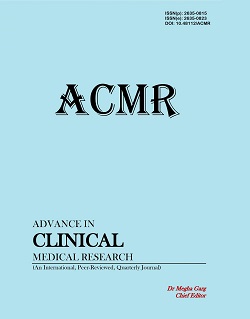Autism Diagnostic Observation Schedule in the Assessment of Cognitive Outcome in Children with Autism Spectrum Disorder in a Tertiary Medical Center of Bangladesh
Autism Diagnostic Observation Schedule in the Assessment of Cognitive Outcome in Children with Autism Spectrum
Keywords:
Autism Spectrum Disorder (ASD), Autism Diagnostic Observation Schedule (ADOS), Cognitive Assessment, Developmental Outcomes, Behavioral EvaluationAbstract
 Abstract Views: 162
Abstract Views: 162
Background: Autism Spectrum Disorder (ASD) is a multifaceted neurodevelopmental condition characterized by social communication deficits, restricted interests, and repetitive behaviors. Accurate cognitive assessment in children with ASD is essential for guiding individualized treatment strategies, yet traditional tools often fall short in evaluating their distinct cognitive and social profiles. The Autism Diagnostic Observation Schedule (ADOS) is a standardized, play-based assessment designed to capture behavioral features of ASD, and may also offer insights into cognitive functioning. Both the generic version (ADOS-G) and the second edition (ADOS-2), including Module 1 and Module 2, were administered. Objective: This study aimed to explore the utility of ADOS in assessing cognitive outcomes among children diagnosed with ASD and to examine correlations between ADOS scores and results from standardized cognitive assessments. Materials and Methods: A cross-sectional observational study was conducted at the Institute of Paediatric Neurodisorder and Autism, Bangladesh Medical University. A total of 161 children aged 1 to 16 years, diagnosed with ASD based on DSM-5 criteria, were included. Each child was assessed using the ADOS module appropriate for their age and language level. Cognition level was measured by using BSID- Ⅱ/ⅠⅡ scales. Data on demographics, clinical characteristics, ADOS scores, and cognitive assessment outcomes were collected and analyzed using SPSS-26. Results: The mean participant age was 4.34 ± 2.17 years, with a male predominance (78.3%). Delayed or non-functional speech was reported in 64.1% of children. Key presenting issues included poor responsiveness (76.4%), limited eye contact (55.9%), and speech delay (49.7%). ADHD was the most common comorbidity (56.5%). Significant correlations were identified between ADOS communication and social interaction scores and cognitive performance, especially in language and adaptive behavior. Conclusion: ADOS proves valuable not only for diagnosing ASD but also in capturing cognitive and behavioral patterns. When integrated with standard cognitive assessments, it enhances understanding of individual developmental trajectories, informing more tailored interventions. Longitudinal studies are recommended to validate these findings and assess intervention outcomes.
References
Posar, A., Resca, F. and Visconti, P., 2015. Autism according to diagnostic and statistical manual of mental disorders 5th edition: The need for further improvements. Journal of pediatric neurosciences, 10(2), pp.146-148.
Lord, C., Cook, E.H., Leventhal, B.L. and Amaral, D.G., 2000. Autism spectrum disorders. Neuron, 28(2), pp.355-363.
Hassan, M.M. and Mokhtar, H.M., 2019. Investigating autism etiology and heterogeneity by decision tree algorithm. Informatics in Medicine Unlocked, 16, p.100215.
Howlin, P., Mawhood, L., & Rutter, M. (2000). Autism and developmental receptive language disorder–a follow-up comparison in early adult life. Journal of Child Psychology and Psychiatry, 41(5), 561–578.
Volkmar, F.R. and Klin, A., 2005. Issues in the classification of autism and related conditions. In: F.R. Volkmar, R. Paul, A. Klin and D. Cohen, eds. Handbook of Autism and Pervasive Developmental Disorders. 3rd ed. Hoboken: Wiley, pp.5–41.
Charman, T., Pickles, A., Simonoff, E., Chandler, S., Loucas, T. and Baird, G., 2011. IQ in children with autism spectrum disorders: Data from the Special Needs and Autism Project (SNAP). Psychological Medicine, 41(3), pp.619-627.
Goldstein, S. and Naglieri, J.A., 2014. Assessment of Autism Spectrum Disorder. New York: Guilford Press.
Lord, C., Rutter, M., DiLavore, P. and Risi, S., 1999. Autism Diagnostic Observation Schedule: Manual. Los Angeles: Western Psychological Services.
Rutter, M., Le Couteur, A. and Lord, C., 2003. Autism diagnostic interview-revised. Los Angeles, CA: Western Psychological Services, 29(2003), p.30.
Loomes R, Hull L, Mandy WPL. What Is the Male-to-Female Ratio in Autism Spectrum Disorder? A Systematic Review and Meta-Analysis. J Am Acad Child Adolesc Psychiatry. 2017;56(6):466-474.
Lord, C., Risi, S., Lambrecht, L., Cook, E.H., Leventhal, B.L., DiLavore, P.C., Pickles, A. and Rutter, M., 2000. The Autism Diagnostic Observation Schedule—Generic: A standard measure of social and communication deficits associated with the spectrum of autism. Journal of autism and developmental disorders, 30, pp.205-223.
Charman, T., Pickles, A., Simonoff, E., Chandler, S., Loucas, T. and Baird, G., 2011. IQ in children with autism spectrum disorders: Data from the Special Needs and Autism Project (SNAP). Psychological Medicine, 41(3), pp.619-627.
American Psychiatric Association, DSM-5 Task Force. (2013). Diagnostic and statistical manual of mental disorders: DSM-5™ (5th ed.). American Psychiatric Publishing, Inc.
Zwaigenbaum, L., Bauman, M. L., Choueiri, R., Kasari, C., Carter, A., Granpeesheh, D., ... & Natowicz, M. R. (2015). Early intervention for children with autism spectrum disorder under 3 years of age: Recommendations for practice and research. Pediatrics, 136(Supplement 1), S60–S81.
Leitner, Y. (2014). The co-occurrence of autism and attention deficit hyperactivity disorder in children – what do we know? Frontiers in Human Neuroscience, 8, 268.
Tuchman, R., & Rapin, I. (2002). Epilepsy in autism. Lancet Neurology, 1(6), 352–358.
Amiet, C., Gourfinkel-An, I., Bouzamondo, A., Tordjman, S., Baulac, M., Lechat, P., ... & Cohen, D. (2008). Epilepsy in autism is associated with intellectual disability and gender: evidence from a meta-analysis. Biological Psychiatry, 64(7), 577–582.
Ozonoff, S., Macari, S., Young, G. S., Goldring, S., Thompson, M., & Rogers, S. J. (2008). A prospective study of the emergence of early behavioral signs of autism. Journal of the American Academy of Child & Adolescent Psychiatry, 47(3), 254–263.
Landa, R. J., & Garrett-Mayer, E. (2006). Development in infants with autism spectrum disorders: A prospective study. Journal of Child Psychology and Psychiatry, 47(6), 629–638.
Garrett-Mayer E. The continual reassessment method for dose-finding studies: a tutorial. Clinical trials. 2006 Feb;3(1):57-71.
Wetherby, A. M., Watt, N., Morgan, L., & Shumway, S. (2007). Social communication profiles of children with autism spectrum disorders late in the second year of life. Journal of Autism and Developmental Disorders, 37(5), 960–975.
Lord, C., Risi, S., DiLavore, P. S., Shulman, C., Thurm, A., & Pickles, A. (2006). Autism from 2 to 9 years of age. Archives of General Psychiatry, 63(6), 694–701.




 OAI-PMH
OAI-PMH 